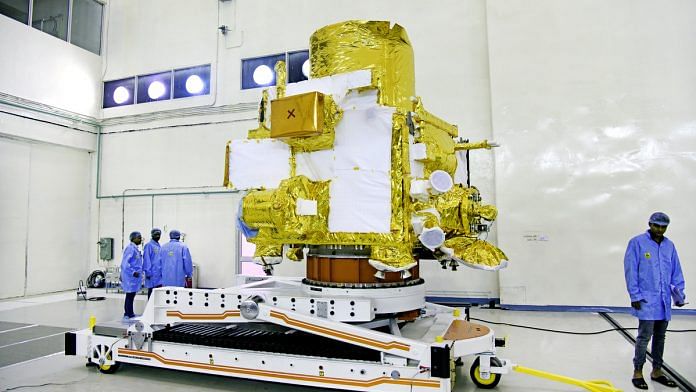Bengaluru: ISRO called off the launch of its ambitious Chandrayaan-2 minutes before it was scheduled to take off at 2.51 am Monday.
The space agency cited a “technical snag” as the reason for cancellation, saying the new date will be declared later.
A technical snag was observed in launch vehicle system at 1 hour before the launch. As a measure of abundant precaution, #Chandrayaan2 launch has been called off for today. Revised launch date will be announced later.
— ISRO (@isro) July 14, 2019
Chandrayaan-2 is India’s second mission to the Moon.
Described as ISRO’s most complex mission so far, Chandrayaan-2 is expected to land an orbiter on the Moon and build on its predecessor’s breakthrough discovery of water on the Earth’s satellite.
Its vehicle is the GSLV Mk-III, India’s most powerful rocket.
Chandrayaan-2 consists of three spacecraft: The Chandrayaan-2 orbiter, the Vikram lander (named after Vikram Sarabhai, the father of India’s space programme), and the Pragyaan rover.
The mission aims to explore the region near the Moon’s south pole, where the lander was to touchdown on 6 or 7 September, if the launch date had been kept.
The mission has been in the making for several years now and was plagued by a series of problems, causing much delay for the launch. In April, the Vikram lander failed a test when its legs fractured, causing the mission to be pushed back further.
Also read: ISRO Chandrayaan-2 mission: Limited to symbolic national pride or is there a scientific gain?
A long journey
While the GSLV employed in the mission is India’s most powerful, it doesn’t compare very well to some of the big rockets from around the world.
Unlike NASA’s Saturn V, or even the Falcon 9 of the private company SpaceX, which delivers payloads to the International Space Station, the GSLV Mk-III is not powerful enough to drop a spacecraft directly onto a path to the Moon.
Instead, the rocket’s fourth stage, into which the orbiter and the lander (which contains the rover within it) are stacked on each other, is supposed to inject Chandrayaan-2 into the Earth’s orbit at an altitude of 182 km.
The spacecraft has been programmed to then perform a series of orbit-raising manoeuvres around the Earth. With each orbit, it is to use the planet’s gravity to gain some more altitude, finally escaping the Earth’s gravitational pull in its sixth orbit, around 17 days from launch.
The whole spacecraft is then supposed to fly towards the Moon, taking five days to complete the journey. For nearly a month after that, the orbiter will perform lunar manoeuvres: It will first reorient itself near the Moon and then fire its engines again to act as a brake.
The craft will then enter into a lunar orbit by performing orbit lowering manoeuvres. It is to subsequently settle into its home, in a circular orbit 100km over the Moon’s surface.
The lander will eventually separate from the orbiter and perform a controlled descent towards the landing site.
A successful landing for Chandrayaan-2 will make India the fourth country to perform a landing on the Moon. Upon landing, the rover will be deployed through a ramp on to the lunar south pole region.
The south polar region is unexplored so far. This is the region where Chandrayaan-1 discovered water ice in 2008 when it crashed an impactor onto the surface and studied the debris thrown up.
The pole has one of the largest craters in the solar system, called the Aitken basin. It is thought that the impact that created the crater was so intense that a part of the lunar rock melted, bringing material from the mantle to the top.
As a result, the geology of the south pole region is very different from that of the rest of the Moon.
The region is dotted by large craters. Owing to the angle of the Sun, several shadowed parts of these craters have never seen sunlight at all. These act as pristine fossils of the early solar system, and are expected to give us information about the formation of the Earth-Moon system, as well as the Sun and its planets.
The payloads are also supposed to study the mineral mapping of the surface, the composition of gases near the Moon, surface and sub-surface geology, as well as moonquakes.
Public outreach
Despite the odd time, hordes of enthusiasts had reached the island, some of them travelling long distances on two wheelers, to witness the historic moment, reported PTI.
President Ram Nath Kovind was also in Sriharikota to witness the launch.
However, the public who were waiting to watch the launch from the new Launch View Gallery at Sriharikota left the venue disappointed as the mission did not go as expected.
Confusion prevailed for several minutes before ISRO confirmed that the launch had been cancelled.
With this mission, ISRO is seeking to shed its reputation of being closed and disconnected.
Much like during the launch of the Mars Orbiter Mission, the globally-celebrated project that saw India reach the Red Planet on its maiden attempt, ISRO has once again become active on social media.
It has also launched an official YouTube channel, which hosts explainer videos.
Also read: Why Chandrayaan-2 is ISRO’s ‘most complex mission’ so far



